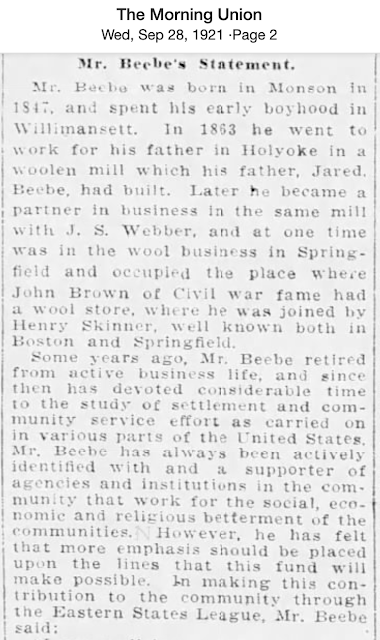The woolen industry was a contributor to Holyoke's economic engine from the mid-19th century into the 20th century. Major woolen product producers included Germania Mills, Connors' Brothers-New York woolen mill, and Germania Woolen Company. All three were situated a short walk from each other in the locales of Race, South, and Main Streets. Today's installment tells the story of the Beebe & Webber Company.
Jared Beebe was born in 1815 in Wilbraham, MA., where he received an elementary education. At an early age, he went to work for the Holmes & Reynolds woolen mills in Monson. In 1956, his employer expanded operations to a new mill in Somersville, CT, and placed Mr. Beebe in charge of the mill. Soon after, he established his own mill in Willimansett (now part of Chicopee), MA.
A partnership was formed in 1863, and four partners contributed a total of $40,000 to fund the business. Jared Beebe was the general partner, and the three limited partners were Joel S. Webber, Ezekiel Blake, and Jerome Wells. The business was known as Jared Beebe & Company.
In November 1872, Jared Beebe sold the Holyoke enterprise to his son, Frank Beebe, and his son-in-law, Joel Webber. The initial business name was Webber & Beebe, which was later changed to Beebe & Webber.
On July 31, 1876, Jared Beebe died. During his lifetime, he established a woolen mill in North Monson, MA, was a founder of the Beebe & Holbrook Paper Company, was a stockholder and president of the Farr Alpaca Company, a director of an Agawam bank, and a successful real estate investor. It was a story of growing up in humble surroundings and becoming a self-made success.
The plant reopened after being closed for four months in early 1876. Twelve broad looms were added to produce a fine cloth, with four additional looms forthcoming.
In 1885, the renamed Beebe & Webber Co. built a two-story building for its wool operations. The second floor provided 175 by 36 feet of space for this purpose. A skylight was constructed over each loom to provide adequate lighting. The first floor was used for finishing and storage.
In 1888, architect Ellsworth drew plans for Joel S. Webber's new home to be built at the corner of Chestnut and Essex Streets. The formal address was 188 Chestnut Street.
A reduction in force occurred in 1891 due to a decline in orders.
There were discussions in 1899 about Beebe & Webber joining a woolen combine with several other wool mills. Unlike Merrick Thread joining the American Thread Trust, this did not occur with Beebe & Webber.
In May 1914, Henry Beebe Sr. and Jr. traveled to Pittsfield, MA, to discuss the sale of Beebe's interest in the firm with a prospective buyer. Joel Webber would not relinquish his interest as part of the plan. The business was struggling and on the brink of closure; however, there were sufficient orders to keep the firm going for five more months of production.
The Holyoke Board of Trade became involved, as 200 jobs would be impacted if the plant were to close. It was estimated that $100,000 of local capital would be required to purchase the firm.
The story continues with the Holyoke Worsted Mills Company in Part 2 of this series.
Addendum: The Beebe & Webber mill building was sold to Jesse Sheldon in 1919. Holyoke Wire Cloth Company, a newly formed corporation employing twenty, leased the space at 694 Main Street.
Citations:
Newspapers.com (paid subscription): Citations: Holyoke (Massachusetts) Transcript & Transcript-Telegram; Springfield (Massachusetts) Republican; publication dates and pages are shown.
Ancestry.com (paid subscription), Price & Lee City Directories, Holyoke, Massachusetts.











































No comments:
Post a Comment